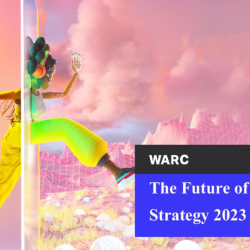In the business of problem-solving and creativity, strategy is the art of balancing multiple inputs, options and directions. And providing clarity through brutal reduction of them. Achieving balance in this process comes from a relentless focus on simplicity. In the same way a heavily loaded bike will rock all over the place, so will a confused strategy laden with ‘insights’, observations, and multiple ways forward.
There is an understandable and inherent fear of simplicity, particularly for those in the early part of their career. If you’ve spent a week analysing a problem and developing a strategy there is a feeling that you need to ‘show your working’ with copious slides, words, and diagrams. This isn’t strategy.
The more that’s included and the more complicated a strategy is, the more ways of interpreting it there are. This is dangerous. Strategy is the act of lighting the way forward, the route to success. If you keep changing direction you won’t reach your destination.
This is seen all too often in the marketing industry. The reason campaigns like Should’ve gone to Specsavers stands out so much is because it’s so rare that a brand sticks with an idea and brand strategy for a long period. The average tenure of a CMO being 3-4 years leads to a short-term cycle of changes in direction. Brand-building vs activation, acquisition vs retention, long-term vs short-term. The more frequently the direction changes, the more baggage and brand fat is acquired in the minds of customers.
In its cleanest form, strategy is reduction. It’s as much about what not to do as what to do. Ultimately, strategy is sacrifice. When you achieve the confidence to reduce days of analysis and strategic development down to a single sentence that guides the way forward in an enlightening and clear way, it’s an intensely liberating experience. Some of the most famous brand ideas of all time have followed this ethos; from Tesco’s Every little helps to Avis’ We try harder, from Stella Artois’ Reassuringly expensive to The AA’s The fourth emergency service. All of these are simple, clear, and brilliant. Not a single superfluous word.
Reduction also achieves balance. If you have reduced the constituent parts to their simplest forms, you can be confident that you have given equal weighting to the problem, the audience, the product, and popular culture. Overweighting one or several of these will leave you with bloated, imbalanced strategic thinking.
But how do you know what to strip away? How can you tell the difference between the elements that provide clarity and the parts that add baggage and imbalance to the strategy?
Start by asking whether they are truly unique to the current problem you’re solving. If it’s category generic, true of any brand, remove it. If it’s an obvious fact (hello ‘Mums are busy‘, ‘Gen Z like experiences‘ and ‘we’re living in a hybrid world‘), remove it. If it’s not tangibly useful for developing the tactics that follow strategy, remove it. You’ll be left with something simple (maybe worryingly simple) and incredibly powerful.
Strategy is not an end in itself, it’s a springboard for tactics and further creativity. Great strategies share many of the attributes of springboards in the physical world. They are fixed and firm, but with some give and flexibility. They are pulled tight to give the greatest propulsion. And most of all they give a sense of liberation and freedom to the people using them.
So if you seek strategic balance, embrace reduction and simplicity. You’ll feel a weight has been lifted.
Featured image: Susan Flores / Pexels
































